Extrinsic Motivation Impact on Employee Performance: A Detailed Essay
VerifiedAdded on 2020/04/13
|8
|2680
|71
Essay
AI Summary
This essay delves into the critical topic of employee motivation within the context of Human Resource Management. It begins by defining motivation and differentiating between intrinsic and extrinsic forms, emphasizing the role of external factors like rewards, incentives, and competition in driving employee performance. The essay then explores the impact of extrinsic motivation on organizational outcomes, highlighting the benefits of financial incentives and close supervision, while also acknowledging potential drawbacks such as the potential for temporary effects and the reduction of intrinsic interest. Furthermore, it examines various factors that influence employee motivation, including effective leadership, career advancement opportunities, workplace environment quality, managerial relations, and the impact of organizational changes and job security. The analysis underscores the importance of a balanced approach, integrating both extrinsic and intrinsic motivators to foster a productive and engaged workforce, ultimately contributing to the achievement of organizational goals and objectives.
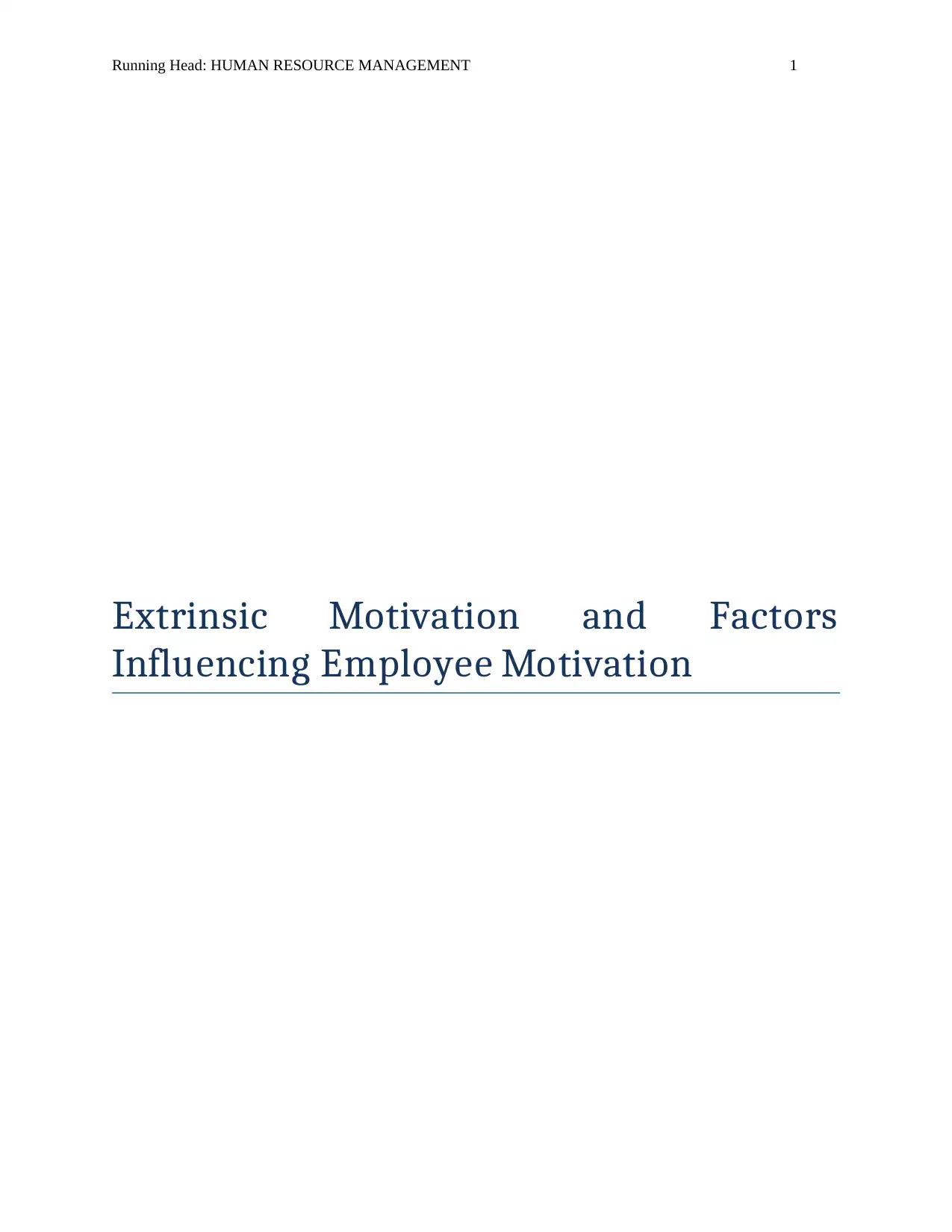
Running Head: HUMAN RESOURCE MANAGEMENT 1
Extrinsic Motivation and Factors
Influencing Employee Motivation
Extrinsic Motivation and Factors
Influencing Employee Motivation
Paraphrase This Document
Need a fresh take? Get an instant paraphrase of this document with our AI Paraphraser
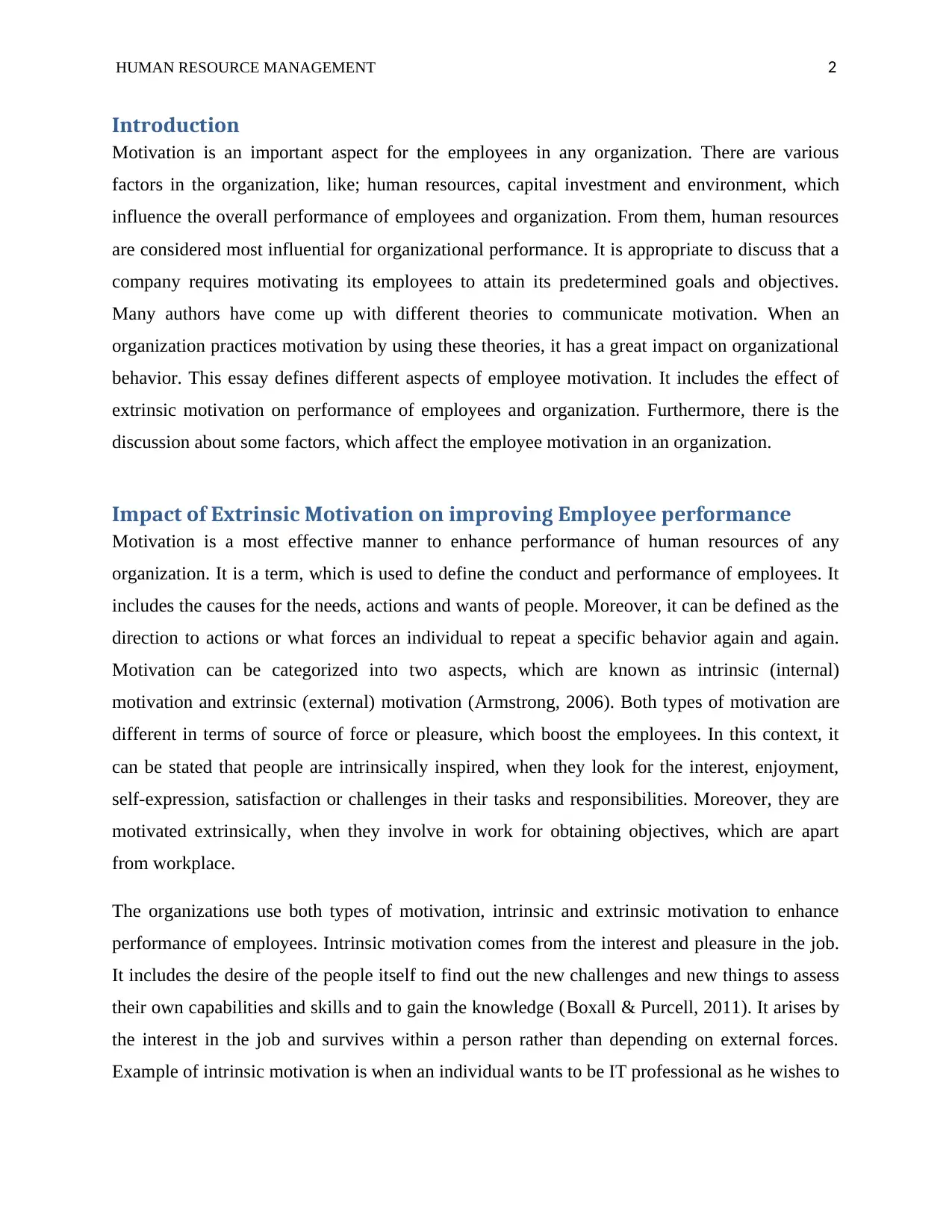
HUMAN RESOURCE MANAGEMENT 2
Introduction
Motivation is an important aspect for the employees in any organization. There are various
factors in the organization, like; human resources, capital investment and environment, which
influence the overall performance of employees and organization. From them, human resources
are considered most influential for organizational performance. It is appropriate to discuss that a
company requires motivating its employees to attain its predetermined goals and objectives.
Many authors have come up with different theories to communicate motivation. When an
organization practices motivation by using these theories, it has a great impact on organizational
behavior. This essay defines different aspects of employee motivation. It includes the effect of
extrinsic motivation on performance of employees and organization. Furthermore, there is the
discussion about some factors, which affect the employee motivation in an organization.
Impact of Extrinsic Motivation on improving Employee performance
Motivation is a most effective manner to enhance performance of human resources of any
organization. It is a term, which is used to define the conduct and performance of employees. It
includes the causes for the needs, actions and wants of people. Moreover, it can be defined as the
direction to actions or what forces an individual to repeat a specific behavior again and again.
Motivation can be categorized into two aspects, which are known as intrinsic (internal)
motivation and extrinsic (external) motivation (Armstrong, 2006). Both types of motivation are
different in terms of source of force or pleasure, which boost the employees. In this context, it
can be stated that people are intrinsically inspired, when they look for the interest, enjoyment,
self-expression, satisfaction or challenges in their tasks and responsibilities. Moreover, they are
motivated extrinsically, when they involve in work for obtaining objectives, which are apart
from workplace.
The organizations use both types of motivation, intrinsic and extrinsic motivation to enhance
performance of employees. Intrinsic motivation comes from the interest and pleasure in the job.
It includes the desire of the people itself to find out the new challenges and new things to assess
their own capabilities and skills and to gain the knowledge (Boxall & Purcell, 2011). It arises by
the interest in the job and survives within a person rather than depending on external forces.
Example of intrinsic motivation is when an individual wants to be IT professional as he wishes to
Introduction
Motivation is an important aspect for the employees in any organization. There are various
factors in the organization, like; human resources, capital investment and environment, which
influence the overall performance of employees and organization. From them, human resources
are considered most influential for organizational performance. It is appropriate to discuss that a
company requires motivating its employees to attain its predetermined goals and objectives.
Many authors have come up with different theories to communicate motivation. When an
organization practices motivation by using these theories, it has a great impact on organizational
behavior. This essay defines different aspects of employee motivation. It includes the effect of
extrinsic motivation on performance of employees and organization. Furthermore, there is the
discussion about some factors, which affect the employee motivation in an organization.
Impact of Extrinsic Motivation on improving Employee performance
Motivation is a most effective manner to enhance performance of human resources of any
organization. It is a term, which is used to define the conduct and performance of employees. It
includes the causes for the needs, actions and wants of people. Moreover, it can be defined as the
direction to actions or what forces an individual to repeat a specific behavior again and again.
Motivation can be categorized into two aspects, which are known as intrinsic (internal)
motivation and extrinsic (external) motivation (Armstrong, 2006). Both types of motivation are
different in terms of source of force or pleasure, which boost the employees. In this context, it
can be stated that people are intrinsically inspired, when they look for the interest, enjoyment,
self-expression, satisfaction or challenges in their tasks and responsibilities. Moreover, they are
motivated extrinsically, when they involve in work for obtaining objectives, which are apart
from workplace.
The organizations use both types of motivation, intrinsic and extrinsic motivation to enhance
performance of employees. Intrinsic motivation comes from the interest and pleasure in the job.
It includes the desire of the people itself to find out the new challenges and new things to assess
their own capabilities and skills and to gain the knowledge (Boxall & Purcell, 2011). It arises by
the interest in the job and survives within a person rather than depending on external forces.
Example of intrinsic motivation is when an individual wants to be IT professional as he wishes to
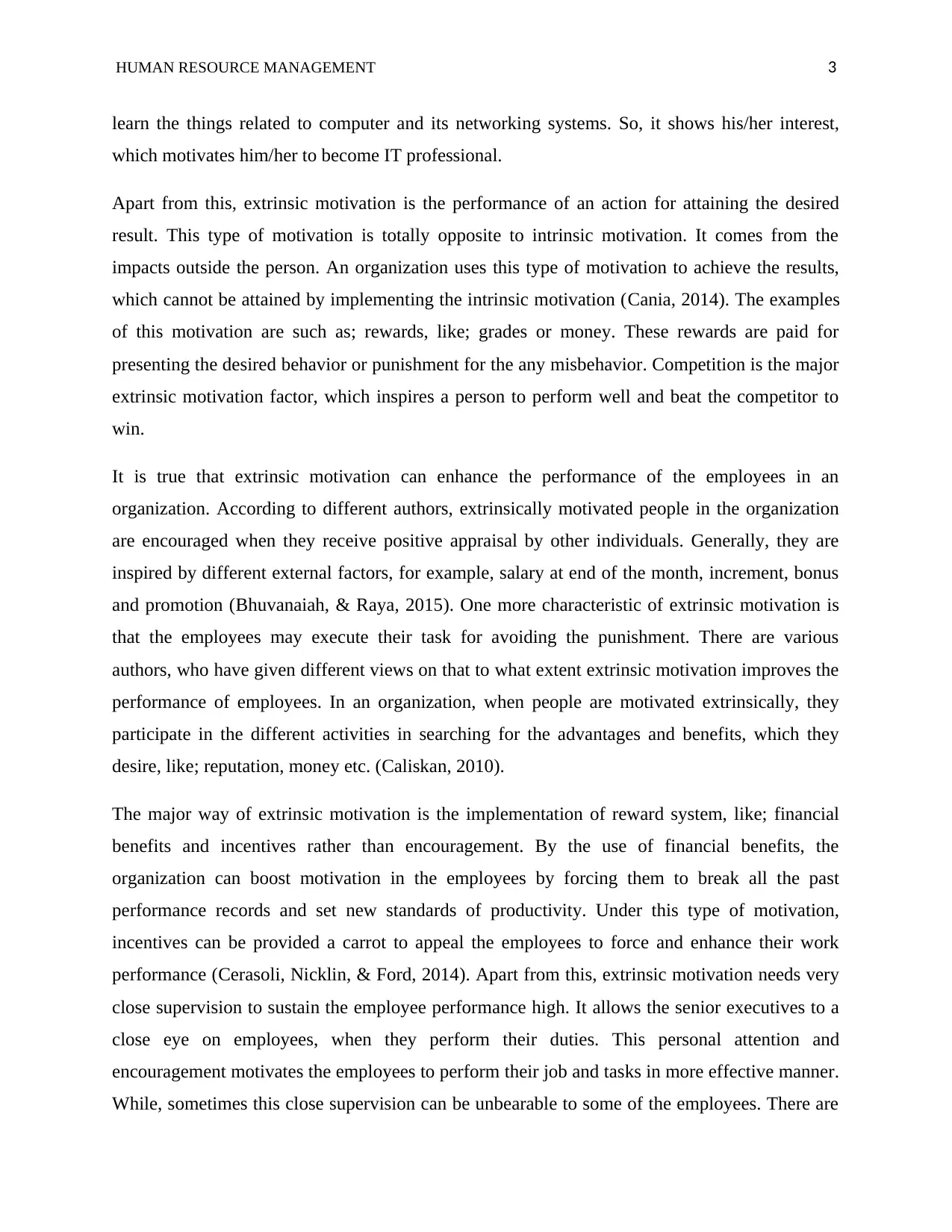
HUMAN RESOURCE MANAGEMENT 3
learn the things related to computer and its networking systems. So, it shows his/her interest,
which motivates him/her to become IT professional.
Apart from this, extrinsic motivation is the performance of an action for attaining the desired
result. This type of motivation is totally opposite to intrinsic motivation. It comes from the
impacts outside the person. An organization uses this type of motivation to achieve the results,
which cannot be attained by implementing the intrinsic motivation (Cania, 2014). The examples
of this motivation are such as; rewards, like; grades or money. These rewards are paid for
presenting the desired behavior or punishment for the any misbehavior. Competition is the major
extrinsic motivation factor, which inspires a person to perform well and beat the competitor to
win.
It is true that extrinsic motivation can enhance the performance of the employees in an
organization. According to different authors, extrinsically motivated people in the organization
are encouraged when they receive positive appraisal by other individuals. Generally, they are
inspired by different external factors, for example, salary at end of the month, increment, bonus
and promotion (Bhuvanaiah, & Raya, 2015). One more characteristic of extrinsic motivation is
that the employees may execute their task for avoiding the punishment. There are various
authors, who have given different views on that to what extent extrinsic motivation improves the
performance of employees. In an organization, when people are motivated extrinsically, they
participate in the different activities in searching for the advantages and benefits, which they
desire, like; reputation, money etc. (Caliskan, 2010).
The major way of extrinsic motivation is the implementation of reward system, like; financial
benefits and incentives rather than encouragement. By the use of financial benefits, the
organization can boost motivation in the employees by forcing them to break all the past
performance records and set new standards of productivity. Under this type of motivation,
incentives can be provided a carrot to appeal the employees to force and enhance their work
performance (Cerasoli, Nicklin, & Ford, 2014). Apart from this, extrinsic motivation needs very
close supervision to sustain the employee performance high. It allows the senior executives to a
close eye on employees, when they perform their duties. This personal attention and
encouragement motivates the employees to perform their job and tasks in more effective manner.
While, sometimes this close supervision can be unbearable to some of the employees. There are
learn the things related to computer and its networking systems. So, it shows his/her interest,
which motivates him/her to become IT professional.
Apart from this, extrinsic motivation is the performance of an action for attaining the desired
result. This type of motivation is totally opposite to intrinsic motivation. It comes from the
impacts outside the person. An organization uses this type of motivation to achieve the results,
which cannot be attained by implementing the intrinsic motivation (Cania, 2014). The examples
of this motivation are such as; rewards, like; grades or money. These rewards are paid for
presenting the desired behavior or punishment for the any misbehavior. Competition is the major
extrinsic motivation factor, which inspires a person to perform well and beat the competitor to
win.
It is true that extrinsic motivation can enhance the performance of the employees in an
organization. According to different authors, extrinsically motivated people in the organization
are encouraged when they receive positive appraisal by other individuals. Generally, they are
inspired by different external factors, for example, salary at end of the month, increment, bonus
and promotion (Bhuvanaiah, & Raya, 2015). One more characteristic of extrinsic motivation is
that the employees may execute their task for avoiding the punishment. There are various
authors, who have given different views on that to what extent extrinsic motivation improves the
performance of employees. In an organization, when people are motivated extrinsically, they
participate in the different activities in searching for the advantages and benefits, which they
desire, like; reputation, money etc. (Caliskan, 2010).
The major way of extrinsic motivation is the implementation of reward system, like; financial
benefits and incentives rather than encouragement. By the use of financial benefits, the
organization can boost motivation in the employees by forcing them to break all the past
performance records and set new standards of productivity. Under this type of motivation,
incentives can be provided a carrot to appeal the employees to force and enhance their work
performance (Cerasoli, Nicklin, & Ford, 2014). Apart from this, extrinsic motivation needs very
close supervision to sustain the employee performance high. It allows the senior executives to a
close eye on employees, when they perform their duties. This personal attention and
encouragement motivates the employees to perform their job and tasks in more effective manner.
While, sometimes this close supervision can be unbearable to some of the employees. There are
⊘ This is a preview!⊘
Do you want full access?
Subscribe today to unlock all pages.

Trusted by 1+ million students worldwide
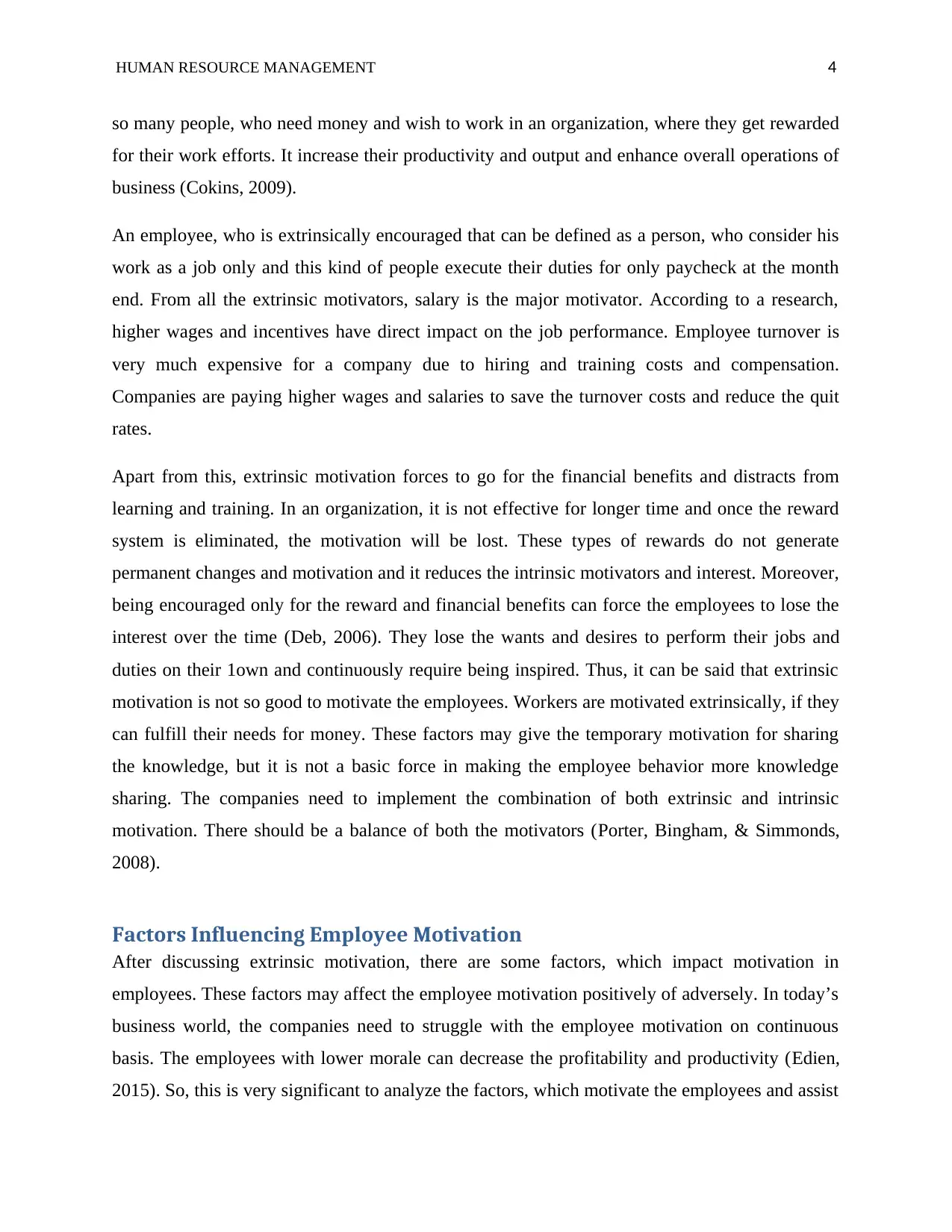
HUMAN RESOURCE MANAGEMENT 4
so many people, who need money and wish to work in an organization, where they get rewarded
for their work efforts. It increase their productivity and output and enhance overall operations of
business (Cokins, 2009).
An employee, who is extrinsically encouraged that can be defined as a person, who consider his
work as a job only and this kind of people execute their duties for only paycheck at the month
end. From all the extrinsic motivators, salary is the major motivator. According to a research,
higher wages and incentives have direct impact on the job performance. Employee turnover is
very much expensive for a company due to hiring and training costs and compensation.
Companies are paying higher wages and salaries to save the turnover costs and reduce the quit
rates.
Apart from this, extrinsic motivation forces to go for the financial benefits and distracts from
learning and training. In an organization, it is not effective for longer time and once the reward
system is eliminated, the motivation will be lost. These types of rewards do not generate
permanent changes and motivation and it reduces the intrinsic motivators and interest. Moreover,
being encouraged only for the reward and financial benefits can force the employees to lose the
interest over the time (Deb, 2006). They lose the wants and desires to perform their jobs and
duties on their 1own and continuously require being inspired. Thus, it can be said that extrinsic
motivation is not so good to motivate the employees. Workers are motivated extrinsically, if they
can fulfill their needs for money. These factors may give the temporary motivation for sharing
the knowledge, but it is not a basic force in making the employee behavior more knowledge
sharing. The companies need to implement the combination of both extrinsic and intrinsic
motivation. There should be a balance of both the motivators (Porter, Bingham, & Simmonds,
2008).
Factors Influencing Employee Motivation
After discussing extrinsic motivation, there are some factors, which impact motivation in
employees. These factors may affect the employee motivation positively of adversely. In today’s
business world, the companies need to struggle with the employee motivation on continuous
basis. The employees with lower morale can decrease the profitability and productivity (Edien,
2015). So, this is very significant to analyze the factors, which motivate the employees and assist
so many people, who need money and wish to work in an organization, where they get rewarded
for their work efforts. It increase their productivity and output and enhance overall operations of
business (Cokins, 2009).
An employee, who is extrinsically encouraged that can be defined as a person, who consider his
work as a job only and this kind of people execute their duties for only paycheck at the month
end. From all the extrinsic motivators, salary is the major motivator. According to a research,
higher wages and incentives have direct impact on the job performance. Employee turnover is
very much expensive for a company due to hiring and training costs and compensation.
Companies are paying higher wages and salaries to save the turnover costs and reduce the quit
rates.
Apart from this, extrinsic motivation forces to go for the financial benefits and distracts from
learning and training. In an organization, it is not effective for longer time and once the reward
system is eliminated, the motivation will be lost. These types of rewards do not generate
permanent changes and motivation and it reduces the intrinsic motivators and interest. Moreover,
being encouraged only for the reward and financial benefits can force the employees to lose the
interest over the time (Deb, 2006). They lose the wants and desires to perform their jobs and
duties on their 1own and continuously require being inspired. Thus, it can be said that extrinsic
motivation is not so good to motivate the employees. Workers are motivated extrinsically, if they
can fulfill their needs for money. These factors may give the temporary motivation for sharing
the knowledge, but it is not a basic force in making the employee behavior more knowledge
sharing. The companies need to implement the combination of both extrinsic and intrinsic
motivation. There should be a balance of both the motivators (Porter, Bingham, & Simmonds,
2008).
Factors Influencing Employee Motivation
After discussing extrinsic motivation, there are some factors, which impact motivation in
employees. These factors may affect the employee motivation positively of adversely. In today’s
business world, the companies need to struggle with the employee motivation on continuous
basis. The employees with lower morale can decrease the profitability and productivity (Edien,
2015). So, this is very significant to analyze the factors, which motivate the employees and assist
Paraphrase This Document
Need a fresh take? Get an instant paraphrase of this document with our AI Paraphraser
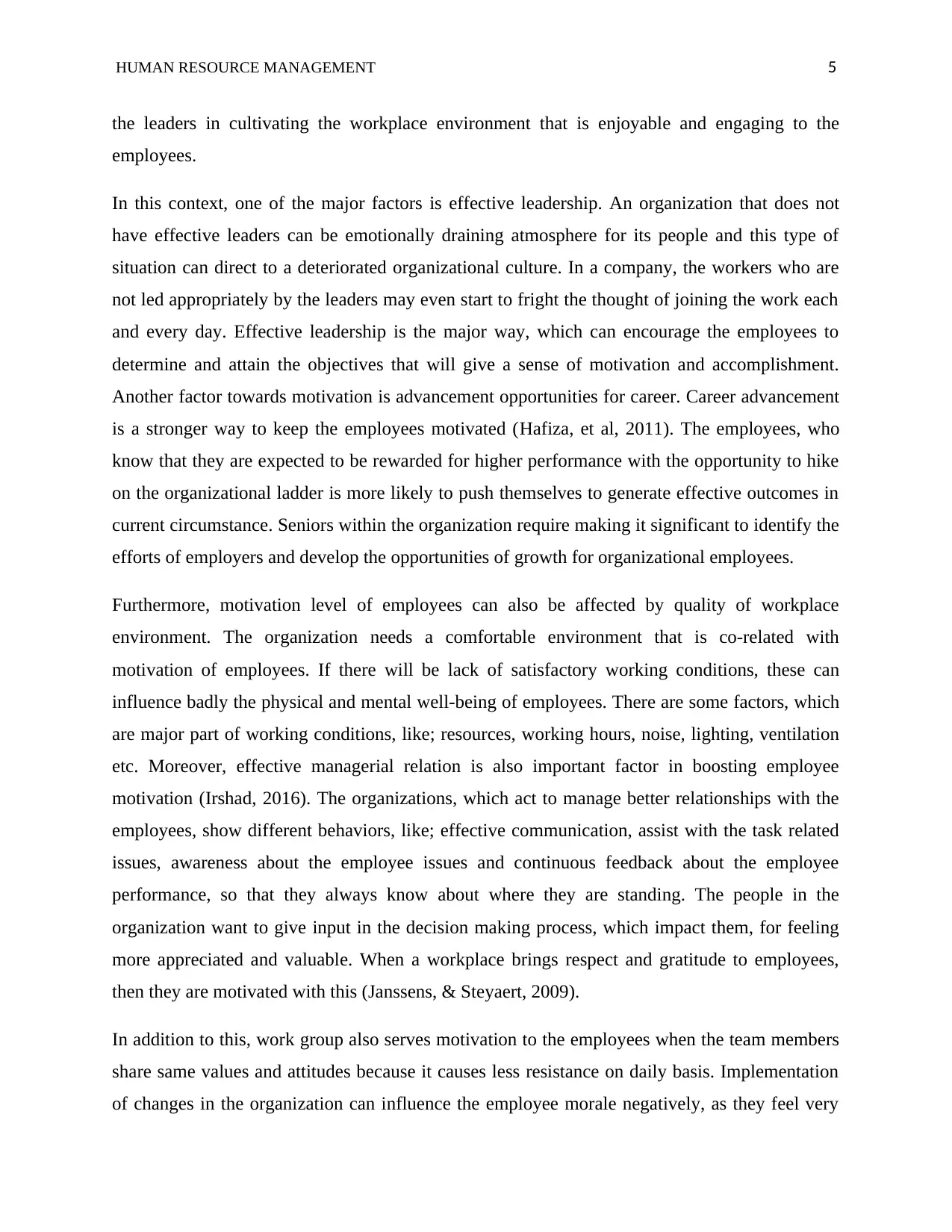
HUMAN RESOURCE MANAGEMENT 5
the leaders in cultivating the workplace environment that is enjoyable and engaging to the
employees.
In this context, one of the major factors is effective leadership. An organization that does not
have effective leaders can be emotionally draining atmosphere for its people and this type of
situation can direct to a deteriorated organizational culture. In a company, the workers who are
not led appropriately by the leaders may even start to fright the thought of joining the work each
and every day. Effective leadership is the major way, which can encourage the employees to
determine and attain the objectives that will give a sense of motivation and accomplishment.
Another factor towards motivation is advancement opportunities for career. Career advancement
is a stronger way to keep the employees motivated (Hafiza, et al, 2011). The employees, who
know that they are expected to be rewarded for higher performance with the opportunity to hike
on the organizational ladder is more likely to push themselves to generate effective outcomes in
current circumstance. Seniors within the organization require making it significant to identify the
efforts of employers and develop the opportunities of growth for organizational employees.
Furthermore, motivation level of employees can also be affected by quality of workplace
environment. The organization needs a comfortable environment that is co-related with
motivation of employees. If there will be lack of satisfactory working conditions, these can
influence badly the physical and mental well-being of employees. There are some factors, which
are major part of working conditions, like; resources, working hours, noise, lighting, ventilation
etc. Moreover, effective managerial relation is also important factor in boosting employee
motivation (Irshad, 2016). The organizations, which act to manage better relationships with the
employees, show different behaviors, like; effective communication, assist with the task related
issues, awareness about the employee issues and continuous feedback about the employee
performance, so that they always know about where they are standing. The people in the
organization want to give input in the decision making process, which impact them, for feeling
more appreciated and valuable. When a workplace brings respect and gratitude to employees,
then they are motivated with this (Janssens, & Steyaert, 2009).
In addition to this, work group also serves motivation to the employees when the team members
share same values and attitudes because it causes less resistance on daily basis. Implementation
of changes in the organization can influence the employee morale negatively, as they feel very
the leaders in cultivating the workplace environment that is enjoyable and engaging to the
employees.
In this context, one of the major factors is effective leadership. An organization that does not
have effective leaders can be emotionally draining atmosphere for its people and this type of
situation can direct to a deteriorated organizational culture. In a company, the workers who are
not led appropriately by the leaders may even start to fright the thought of joining the work each
and every day. Effective leadership is the major way, which can encourage the employees to
determine and attain the objectives that will give a sense of motivation and accomplishment.
Another factor towards motivation is advancement opportunities for career. Career advancement
is a stronger way to keep the employees motivated (Hafiza, et al, 2011). The employees, who
know that they are expected to be rewarded for higher performance with the opportunity to hike
on the organizational ladder is more likely to push themselves to generate effective outcomes in
current circumstance. Seniors within the organization require making it significant to identify the
efforts of employers and develop the opportunities of growth for organizational employees.
Furthermore, motivation level of employees can also be affected by quality of workplace
environment. The organization needs a comfortable environment that is co-related with
motivation of employees. If there will be lack of satisfactory working conditions, these can
influence badly the physical and mental well-being of employees. There are some factors, which
are major part of working conditions, like; resources, working hours, noise, lighting, ventilation
etc. Moreover, effective managerial relation is also important factor in boosting employee
motivation (Irshad, 2016). The organizations, which act to manage better relationships with the
employees, show different behaviors, like; effective communication, assist with the task related
issues, awareness about the employee issues and continuous feedback about the employee
performance, so that they always know about where they are standing. The people in the
organization want to give input in the decision making process, which impact them, for feeling
more appreciated and valuable. When a workplace brings respect and gratitude to employees,
then they are motivated with this (Janssens, & Steyaert, 2009).
In addition to this, work group also serves motivation to the employees when the team members
share same values and attitudes because it causes less resistance on daily basis. Implementation
of changes in the organization can influence the employee morale negatively, as they feel very
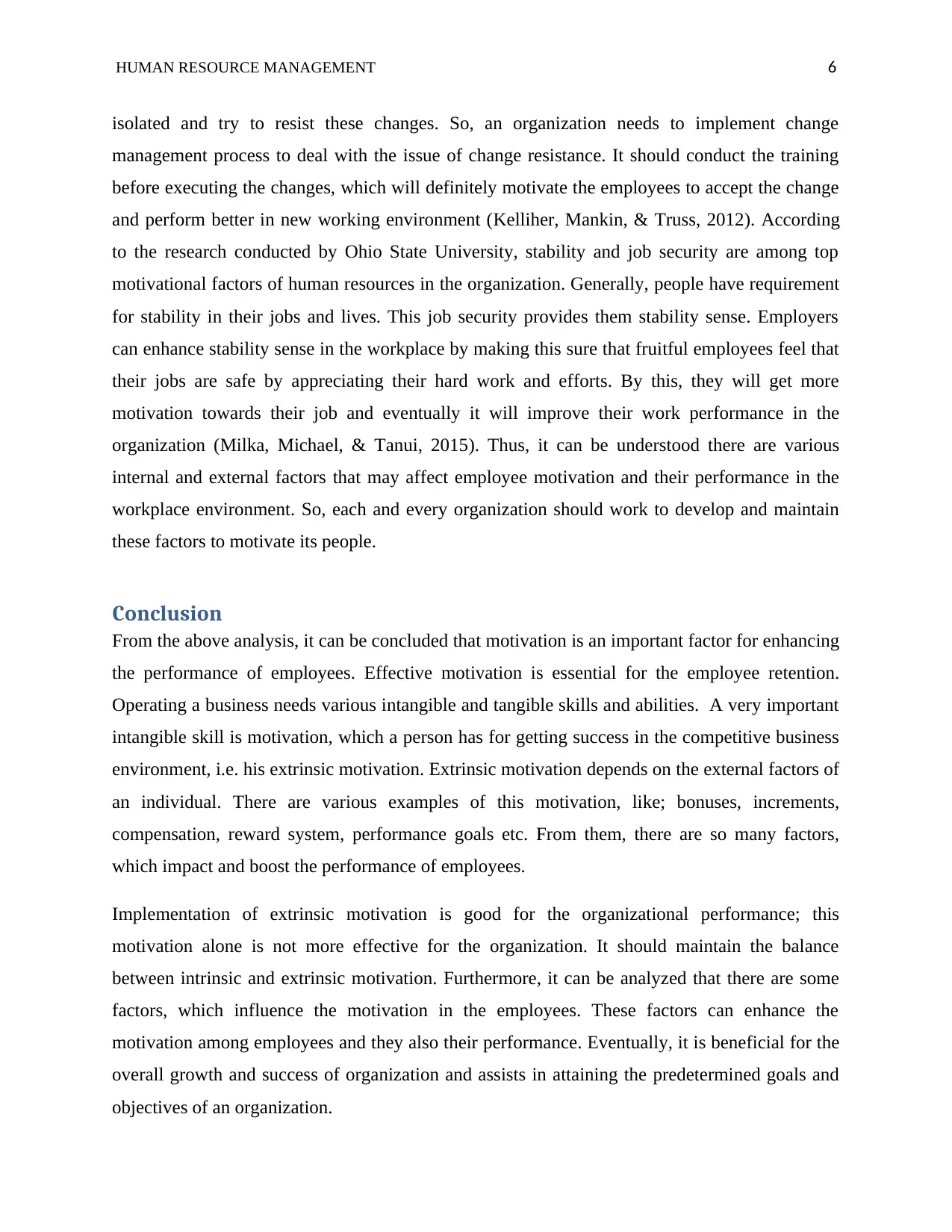
HUMAN RESOURCE MANAGEMENT 6
isolated and try to resist these changes. So, an organization needs to implement change
management process to deal with the issue of change resistance. It should conduct the training
before executing the changes, which will definitely motivate the employees to accept the change
and perform better in new working environment (Kelliher, Mankin, & Truss, 2012). According
to the research conducted by Ohio State University, stability and job security are among top
motivational factors of human resources in the organization. Generally, people have requirement
for stability in their jobs and lives. This job security provides them stability sense. Employers
can enhance stability sense in the workplace by making this sure that fruitful employees feel that
their jobs are safe by appreciating their hard work and efforts. By this, they will get more
motivation towards their job and eventually it will improve their work performance in the
organization (Milka, Michael, & Tanui, 2015). Thus, it can be understood there are various
internal and external factors that may affect employee motivation and their performance in the
workplace environment. So, each and every organization should work to develop and maintain
these factors to motivate its people.
Conclusion
From the above analysis, it can be concluded that motivation is an important factor for enhancing
the performance of employees. Effective motivation is essential for the employee retention.
Operating a business needs various intangible and tangible skills and abilities. A very important
intangible skill is motivation, which a person has for getting success in the competitive business
environment, i.e. his extrinsic motivation. Extrinsic motivation depends on the external factors of
an individual. There are various examples of this motivation, like; bonuses, increments,
compensation, reward system, performance goals etc. From them, there are so many factors,
which impact and boost the performance of employees.
Implementation of extrinsic motivation is good for the organizational performance; this
motivation alone is not more effective for the organization. It should maintain the balance
between intrinsic and extrinsic motivation. Furthermore, it can be analyzed that there are some
factors, which influence the motivation in the employees. These factors can enhance the
motivation among employees and they also their performance. Eventually, it is beneficial for the
overall growth and success of organization and assists in attaining the predetermined goals and
objectives of an organization.
isolated and try to resist these changes. So, an organization needs to implement change
management process to deal with the issue of change resistance. It should conduct the training
before executing the changes, which will definitely motivate the employees to accept the change
and perform better in new working environment (Kelliher, Mankin, & Truss, 2012). According
to the research conducted by Ohio State University, stability and job security are among top
motivational factors of human resources in the organization. Generally, people have requirement
for stability in their jobs and lives. This job security provides them stability sense. Employers
can enhance stability sense in the workplace by making this sure that fruitful employees feel that
their jobs are safe by appreciating their hard work and efforts. By this, they will get more
motivation towards their job and eventually it will improve their work performance in the
organization (Milka, Michael, & Tanui, 2015). Thus, it can be understood there are various
internal and external factors that may affect employee motivation and their performance in the
workplace environment. So, each and every organization should work to develop and maintain
these factors to motivate its people.
Conclusion
From the above analysis, it can be concluded that motivation is an important factor for enhancing
the performance of employees. Effective motivation is essential for the employee retention.
Operating a business needs various intangible and tangible skills and abilities. A very important
intangible skill is motivation, which a person has for getting success in the competitive business
environment, i.e. his extrinsic motivation. Extrinsic motivation depends on the external factors of
an individual. There are various examples of this motivation, like; bonuses, increments,
compensation, reward system, performance goals etc. From them, there are so many factors,
which impact and boost the performance of employees.
Implementation of extrinsic motivation is good for the organizational performance; this
motivation alone is not more effective for the organization. It should maintain the balance
between intrinsic and extrinsic motivation. Furthermore, it can be analyzed that there are some
factors, which influence the motivation in the employees. These factors can enhance the
motivation among employees and they also their performance. Eventually, it is beneficial for the
overall growth and success of organization and assists in attaining the predetermined goals and
objectives of an organization.
⊘ This is a preview!⊘
Do you want full access?
Subscribe today to unlock all pages.

Trusted by 1+ million students worldwide
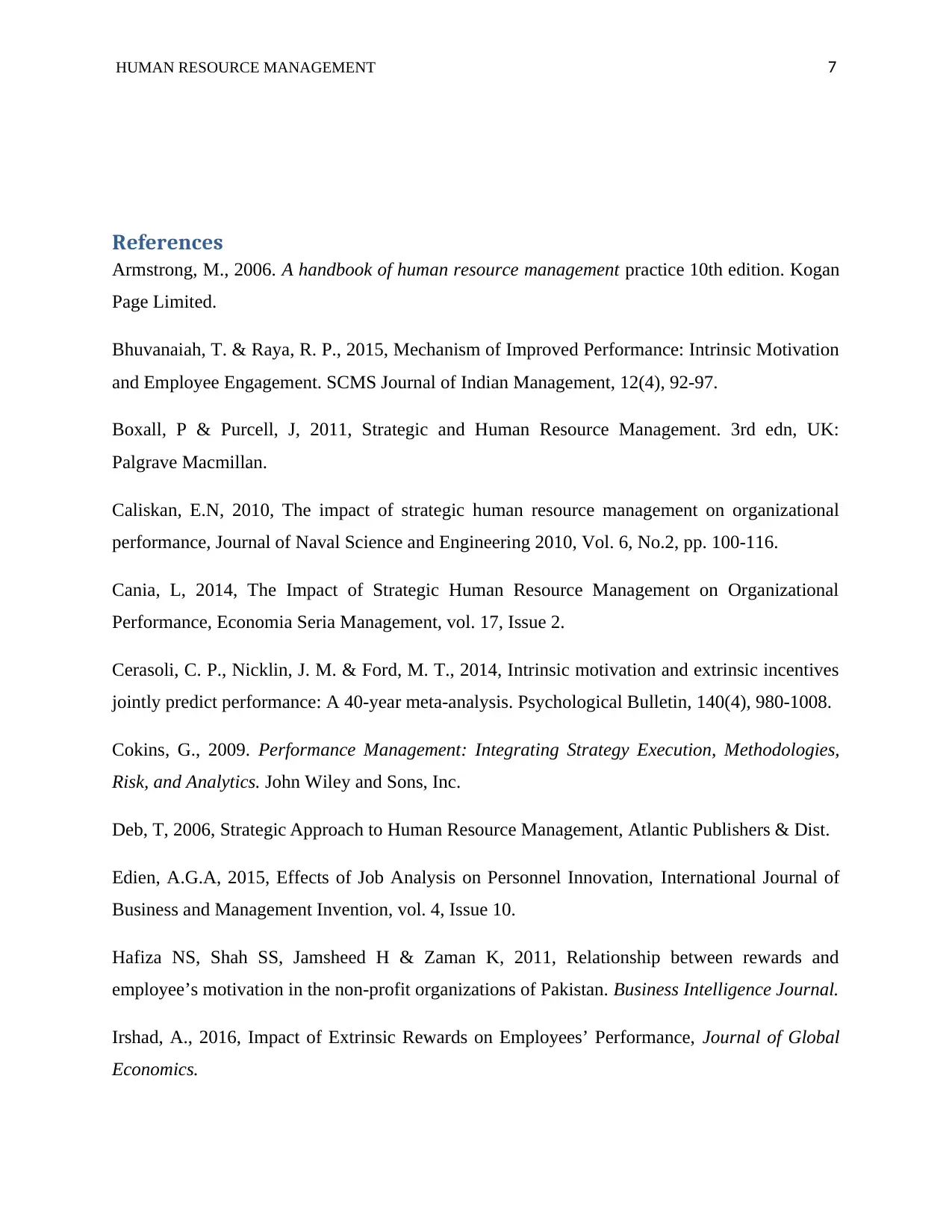
HUMAN RESOURCE MANAGEMENT 7
References
Armstrong, M., 2006. A handbook of human resource management practice 10th edition. Kogan
Page Limited.
Bhuvanaiah, T. & Raya, R. P., 2015, Mechanism of Improved Performance: Intrinsic Motivation
and Employee Engagement. SCMS Journal of Indian Management, 12(4), 92-97.
Boxall, P & Purcell, J, 2011, Strategic and Human Resource Management. 3rd edn, UK:
Palgrave Macmillan.
Caliskan, E.N, 2010, The impact of strategic human resource management on organizational
performance, Journal of Naval Science and Engineering 2010, Vol. 6, No.2, pp. 100-116.
Cania, L, 2014, The Impact of Strategic Human Resource Management on Organizational
Performance, Economia Seria Management, vol. 17, Issue 2.
Cerasoli, C. P., Nicklin, J. M. & Ford, M. T., 2014, Intrinsic motivation and extrinsic incentives
jointly predict performance: A 40-year meta-analysis. Psychological Bulletin, 140(4), 980-1008.
Cokins, G., 2009. Performance Management: Integrating Strategy Execution, Methodologies,
Risk, and Analytics. John Wiley and Sons, Inc.
Deb, T, 2006, Strategic Approach to Human Resource Management, Atlantic Publishers & Dist.
Edien, A.G.A, 2015, Effects of Job Analysis on Personnel Innovation, International Journal of
Business and Management Invention, vol. 4, Issue 10.
Hafiza NS, Shah SS, Jamsheed H & Zaman K, 2011, Relationship between rewards and
employee’s motivation in the non-profit organizations of Pakistan. Business Intelligence Journal.
Irshad, A., 2016, Impact of Extrinsic Rewards on Employees’ Performance, Journal of Global
Economics.
References
Armstrong, M., 2006. A handbook of human resource management practice 10th edition. Kogan
Page Limited.
Bhuvanaiah, T. & Raya, R. P., 2015, Mechanism of Improved Performance: Intrinsic Motivation
and Employee Engagement. SCMS Journal of Indian Management, 12(4), 92-97.
Boxall, P & Purcell, J, 2011, Strategic and Human Resource Management. 3rd edn, UK:
Palgrave Macmillan.
Caliskan, E.N, 2010, The impact of strategic human resource management on organizational
performance, Journal of Naval Science and Engineering 2010, Vol. 6, No.2, pp. 100-116.
Cania, L, 2014, The Impact of Strategic Human Resource Management on Organizational
Performance, Economia Seria Management, vol. 17, Issue 2.
Cerasoli, C. P., Nicklin, J. M. & Ford, M. T., 2014, Intrinsic motivation and extrinsic incentives
jointly predict performance: A 40-year meta-analysis. Psychological Bulletin, 140(4), 980-1008.
Cokins, G., 2009. Performance Management: Integrating Strategy Execution, Methodologies,
Risk, and Analytics. John Wiley and Sons, Inc.
Deb, T, 2006, Strategic Approach to Human Resource Management, Atlantic Publishers & Dist.
Edien, A.G.A, 2015, Effects of Job Analysis on Personnel Innovation, International Journal of
Business and Management Invention, vol. 4, Issue 10.
Hafiza NS, Shah SS, Jamsheed H & Zaman K, 2011, Relationship between rewards and
employee’s motivation in the non-profit organizations of Pakistan. Business Intelligence Journal.
Irshad, A., 2016, Impact of Extrinsic Rewards on Employees’ Performance, Journal of Global
Economics.
Paraphrase This Document
Need a fresh take? Get an instant paraphrase of this document with our AI Paraphraser
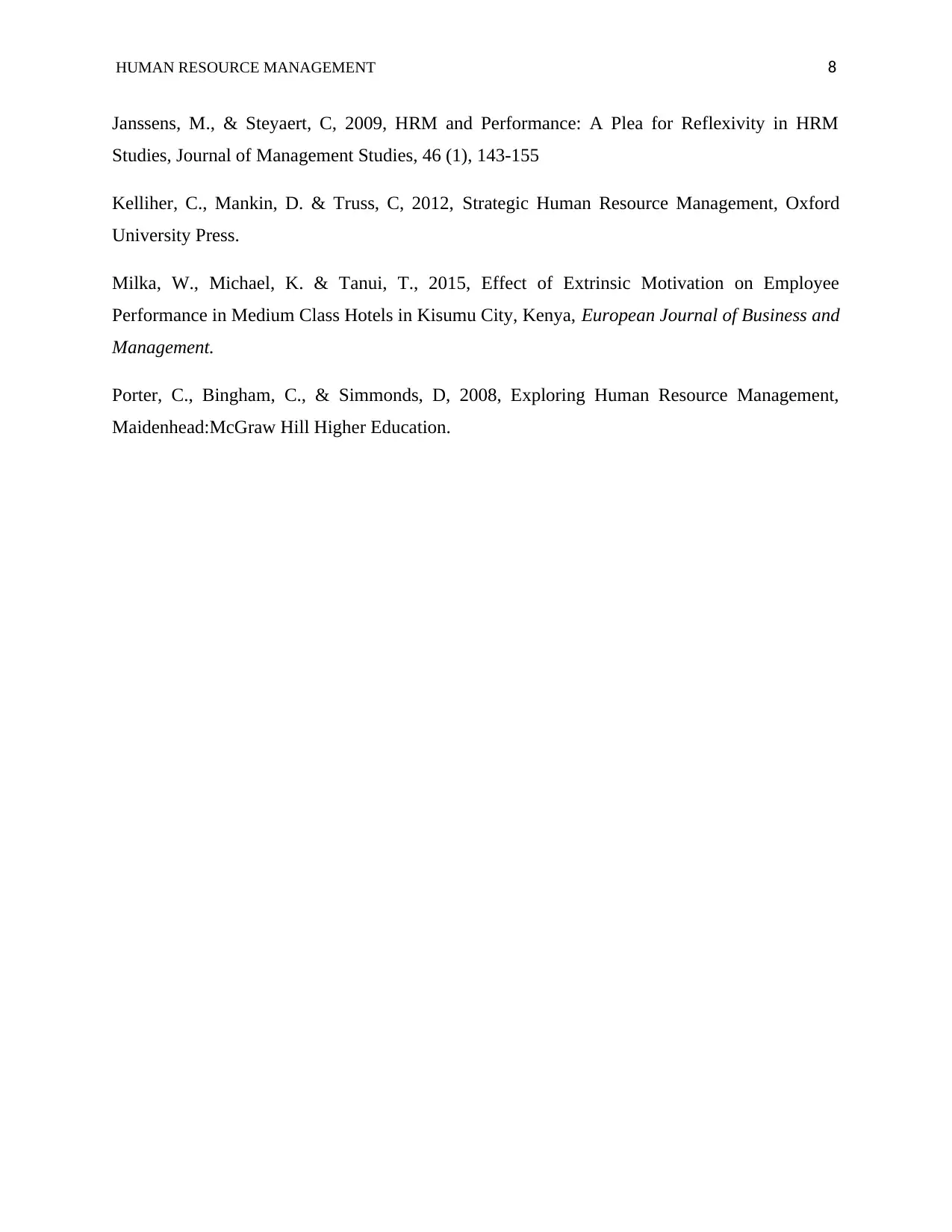
HUMAN RESOURCE MANAGEMENT 8
Janssens, M., & Steyaert, C, 2009, HRM and Performance: A Plea for Reflexivity in HRM
Studies, Journal of Management Studies, 46 (1), 143-155
Kelliher, C., Mankin, D. & Truss, C, 2012, Strategic Human Resource Management, Oxford
University Press.
Milka, W., Michael, K. & Tanui, T., 2015, Effect of Extrinsic Motivation on Employee
Performance in Medium Class Hotels in Kisumu City, Kenya, European Journal of Business and
Management.
Porter, C., Bingham, C., & Simmonds, D, 2008, Exploring Human Resource Management,
Maidenhead:McGraw Hill Higher Education.
Janssens, M., & Steyaert, C, 2009, HRM and Performance: A Plea for Reflexivity in HRM
Studies, Journal of Management Studies, 46 (1), 143-155
Kelliher, C., Mankin, D. & Truss, C, 2012, Strategic Human Resource Management, Oxford
University Press.
Milka, W., Michael, K. & Tanui, T., 2015, Effect of Extrinsic Motivation on Employee
Performance in Medium Class Hotels in Kisumu City, Kenya, European Journal of Business and
Management.
Porter, C., Bingham, C., & Simmonds, D, 2008, Exploring Human Resource Management,
Maidenhead:McGraw Hill Higher Education.
1 out of 8
Related Documents
Your All-in-One AI-Powered Toolkit for Academic Success.
+13062052269
info@desklib.com
Available 24*7 on WhatsApp / Email
![[object Object]](/_next/static/media/star-bottom.7253800d.svg)
Unlock your academic potential
Copyright © 2020–2025 A2Z Services. All Rights Reserved. Developed and managed by ZUCOL.




